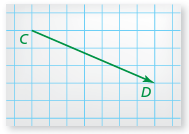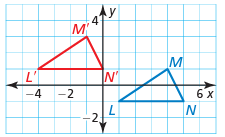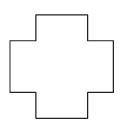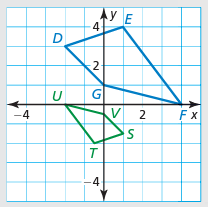(x,y)→(x+h,y+k)
Translation
(-3,4) rotated 180 degrees
(3,-4)
What is the image of point (-5,2) transformed using the vector <3, -2>
(-2,0)
Reflect (4,3) over x-axis
(4,-3)
Dilate (5,9) by a scale factor of 2.5
(12.5, 22.5)
Which transformation can not be used to prove congruency?
Dilation
(x,y)→(-y,x)
Rotation:
90° CCW
270° CW
(5,1) rotated 90°
What is (-1,5)?
What is the component form for this vector?

<7,-3>
(-3,-5)
Dilate (8,4) by (x,y)→(1/4x,1/4y)
(2,1)
What is a transformation that does not change the shape or size of a figure?
Rigid motion
(x,y)→(kx,ky)
Dilation
(2,-4) rotated 360°
What is (2,-4)?
What quadrant does the image of (5, -7) map to under a transformation of (x,y)→(x-8,y)
Quadrant III
Reflect (2, -5) over:
y-axis then the y=-x line
(5,2)
Your pre-image point is at (2,3). Perfom the following transformations:
Reflection across x-axis
Dilation of k=2
(4,-6)
What is a transformation that maps a figure onto another figure that is the same shape, but maybe not the same size?
Similarity Transformation
(x,y)→(y,-x)
Rotation:
270° CCW
90° CW
(-7,-4) rotated 270°
What is (-4,7)?
Write the coordinate rule:

x,y)→(x-5, y+2)
Describe the rules for the following transformation:

1) Transation: (x,y)→(x+2, y+3)
2) Reflection over y-axis: (x,y)→(-x,y)
You know that R(2,4) and R'(8,16). What scale factor was used to map R onto R'?
k=4
How many lines of symmetry does this figure have?

4
(x,y)→(-x,y)
Reflection over y-axis
(-1,9) rotated 450°
What is (-9,-1)?
1) (x,y)→(x+12,y+4)
2) translation along vector <-5, -9>
S''(9, -1)
What transformation is equivalent to reflecting a figure over two parallel lines?
Translation
Describe the transformation(s) that maps quadrilateral DEFG to quadrilateral STUV.
Write ONE rule to describe it.

Dilation of k=1/2 (x,y)→(1/2x, 1/2y)
Rotation of 180° (x,y)→(-x,-y)
(x,y)→(-1/2x,-1/2y)
What is the degree of rotational symmetry for this figure?

72°